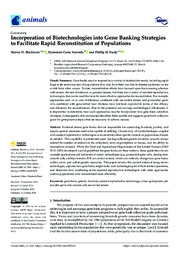Incorporation of biotechnologies into gene banking strategies to facilitate rapid reconstitution of populations.
Incorporation of biotechnologies into gene banking strategies to facilitate rapid reconstitution of populations.
Summary: National animal gene banks that are responsible for conserving livestock, poultry, and aquatic genetic resources need to be capable of utilizing a broad array of cryotechnologies coupled with assisted reproductive technologies to reconstitute either specific animals or populations/breeds as needed. This capability is predicated upon having sufficient genetic diversity (usually encapsulated by number of animals in the collection), units of germplasm or tissues, and the ability to reconstitute animals. While the Food and Agriculture Organization of the United Nations (FAO 2012, 2023) developed a set of guidelines for gene banks on these matters, those guidelines do not consider applications and utilization of newer technologies (e.g., primordial germ cells, cloning from somatic cells, embryo transfer, IVF, sex-sorted semen), which can radically change how gene banks collect, store, and utilize genetic resources. This paper reviews the current status of using newer technologies, explores how gene banks might make such technologies part of their routine operations, and illustrates how combining newer assisted reproductive technologies with older approaches enables populations to be reconstituted more efficiently.
Publication year: 2023
Types of publication: Journal article
Observation
Some of Embrapa's publications are published as ePub files. To read them, use or download one of the following free software options to your computer or mobile device. Android: Google Play Books; IOS: iBooks; Windows and Linux: Calibre.
Access other publications
Access the Agricultural Research Database (BDPA) to consult Embrapa's full library collection and records.
Visit Embrapa Bookstore to purchase books and other publications sold by Embrapa.

